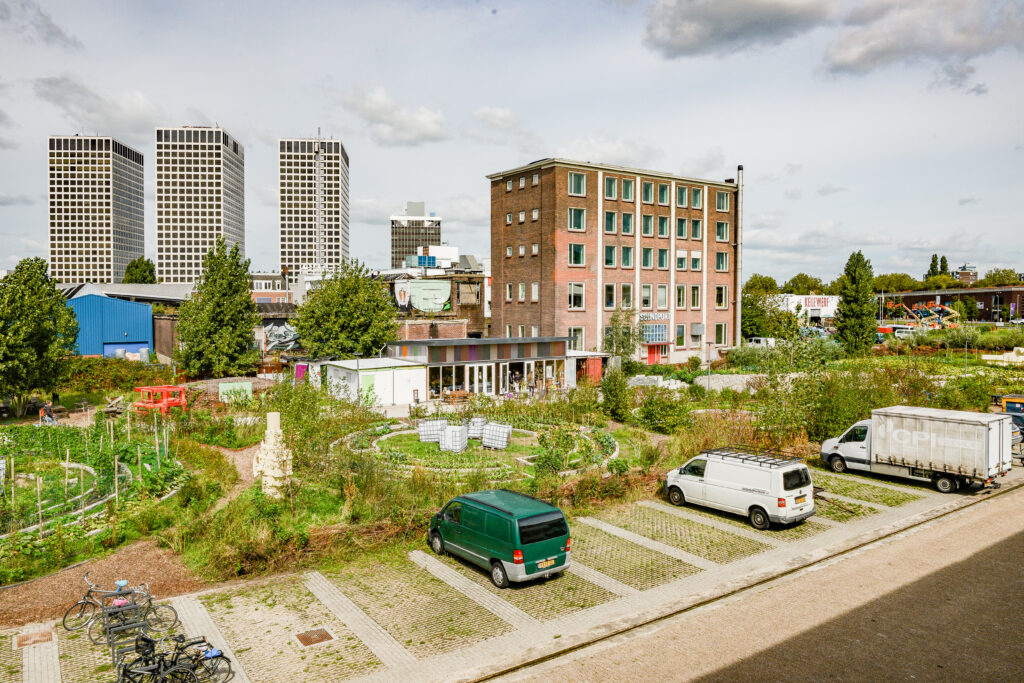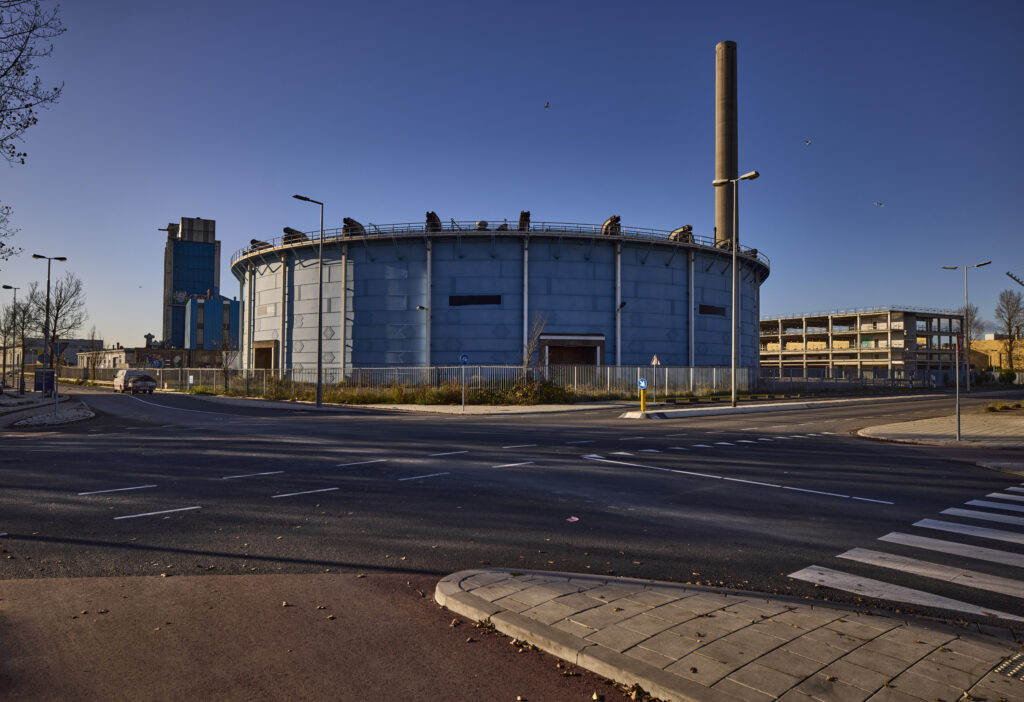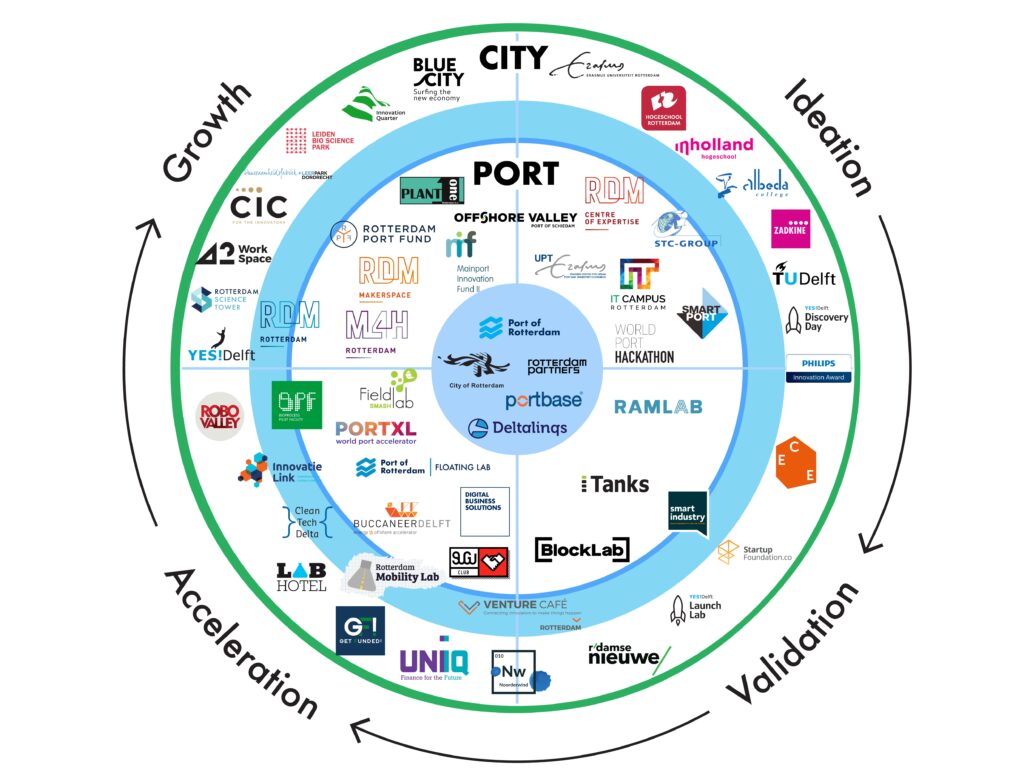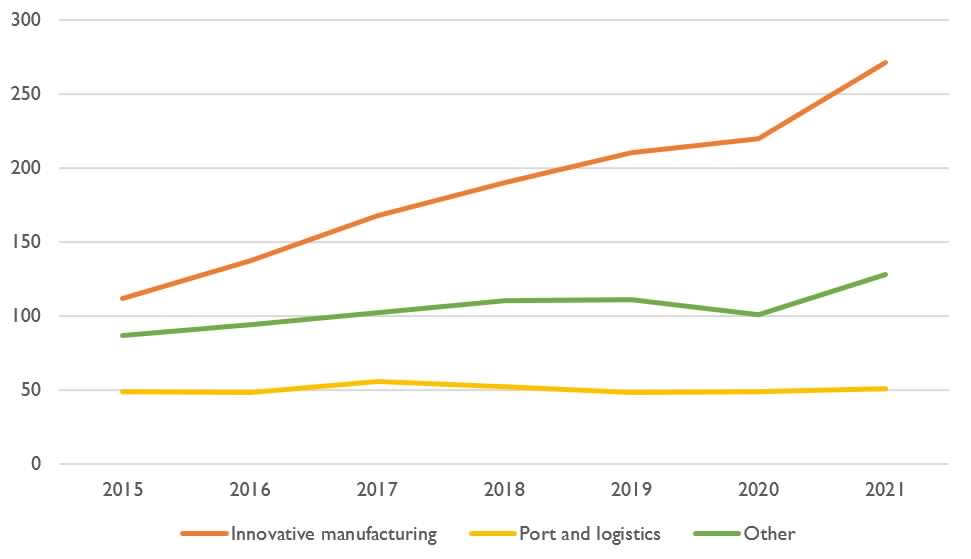╔
Innovation Districts and Port-City Interface
In 2014, the American Brookings Institution published its report on ‘the rise of innovation districts’ (Katz & Wagner, 2014). The authors describe how the landscape of innovation is shifting from mono-functional suburban science parks and isolated campuses to mixed-used highly urbanized areas (see also Zukin, 2020). Katz and Wagner (2014) define these urban ‘innovation districts’ as “geographic areas where leading-edge anchor institutions and companies cluster and connect with start-ups, business incubators and accelerators. They are also physically compact, transit-accessible, and technically wired and offer mixed-used housing, office and retail” (p. 1). Based on the successful implementation of an innovation district in Barcelona, Boston and Medellin, many cities around the world implemented the innovation district model.
Facilitating start-ups in the port-city interface to encourage innovation is a popular policy strategy in port cities (Witte et al., 2018). In the literature, the contemporary port-city interface is often represented as a zone of conflicts between ports and cities (Wiegmans & Lauw, 2011; Van den Berghe et al., 2022). At the same time, scholars have argued that the port-city interface is a strategic asset in port cities to explore new economic orientations and novel land-use combinations (Daamen & Louw, 2016; Pagés-Sánchez & Daamen, 2020). Sustainable development of the port-city interface thus requires collaboration between ports and cities (Carpenter & Lozano, 2020; Daamen & Vries, 2013; Pagés-Sánchez & Daamen, 2020). Innovation districts, and especially the ‘re-imagined urban area’ model (Katz & Wagner, 2014) can enhance this collaboration.
Successful innovation districts build upon three assets (Katz & Wagner, 2014). Economic assets are the innovators in a district such as companies, knowledge institutions and entrepreneurs supported by incubators and accelerators. In addition, neighbourhood-amenities such as grocery stores, restaurants and coffee bars are part of the economic assets. Physical assets are the public and private spaces in the district that facilitate and stimulate connection and collaboration (e.g. co-working spaces). Networking assets are the relationships – both strong and weak ties – between actors in the district that generate and accelerate the development of ideas.
Rotterdam Makers District
Rotterdam has a rich history of transforming old port areas into attractive urban waterfronts. The current focus in Rotterdam is on the transformation of Merwe-Vierhavens, shortly M4H, a 120-hectare port-industrial area historically specialized in storage and transhipment of fruit and juices. Around 2013, the traditional idea of a ‘port-out, city-in’ transformation of M4H was finally abandoned. It was recognized that the port would remain present in M4H for a long time, and, more importantly, that the port also had an interest in an economic transformation of M4H focused on innovation and sustainability, to strengthen the position of Rotterdam’s port. Hence, a joint project team of the municipality and the port authority was established to develop a development strategy for the area, which was first published in 2015.
Keilekwartier is one of the work environments on transition in M4H, where craft enterprises and creative manufacturing businesses fit in. (© Sandra Koning).

Also in 2015, M4H was, together with RDM, launched as the ‘Rotterdam Innovation District’, inspired by the decision of the Boston-based incubator and accelerator Cambridge Innovation Center (CIC) to open their first European location in Rotterdam. RDM, a 30-hectare former shipyard, was already redeveloped by the port authority and some educational institutions into a campus environment for research, education and entrepreneurship. So far, M4H has seen a more ‘organic’ transformation process whereby vacant warehouses in the area have been occupied by local artists and other creative pioneers.
Rotterdam Innovation District however, was soon criticized with the argument that innovation in Rotterdam was not restricted to the new innovation district (e.g. Nuijten, 2017). Other areas, particularly Rotterdam Central District where CIC was and is located, could claim this name too. It became clear that the name, or brand, ‘innovation district’ was not distinctive enough, and that it did not do justice to the innovative manufacturing activities found in the area (Vries, 2017). Hence, in 2017 the name of the area was changed to ‘Rotterdam Makers District’, highlighting the unique character of the area and the specific target group, and the fact that M4H and RDM are complementary rather than competitive to other innovation hotspots in Rotterdam.
The Ferro Gasometer is an important landmark in M4H, located in the area where the ‘Makersstraat’ crosses the ‘Havenallee’. (© Jan de Groen).

Rotterdam Makers District is thus part of a regional innovation ecosystem. Within this ecosystem, the Makers District is nowadays envisioned as the ultimate location for innovative manufacturing activities (e.g. 3D-printing, robotics, digitization, material science, etc.). It is a testing ground and showcase of the circular economy of the port and the city. Hence, the development of Rotterdam Makers District in the port-city interface is a joint development of the municipality and the port authority, making Rotterdam a different case than many other European port cities (Daamen & Vries, 2013; Pagés-Sánchez & Daamen, 2020).

Visual representation of the regional innovation ecosystem in Rotterdam. Rotterdam Makers District is home to various assets of this ecosystem. (Source: Rotterdam Make It Happen; https://rotterdammakeithappen.nl/showcases/rotterdam-innovatie-ecosysteem/).
Economic Assets
The economic assets in M4H are mainly a collection of small and medium sized businesses and individual entrepreneurs. The number of businesses in the area is growing quickly, and the current ‘innovative manufacturing’ activities are a mixture of businesses in arts, crafts, design, engineering, manufacturing, food, life sciences, media and ICT. The port authority and the municipality are now seeing the circular economy, future mobility and the energy transition as the most promising areas to focus on in M4H. Contrasting the definition of an innovation district, businesses in M4H are not clustered around leading-edge anchor institutions or companies, except for the Erasmus Centre for Entrepreneurship (ECE), which is connected to Erasmus University Rotterdam, and Stedin, the local grid manager. ECE is an incubator and accelerator and hosts more than 100 businesses at its campus in the Rotterdam Science Tower in M4H. Stedin has its own corporate school in M4H. The Rotterdam University of Applied Sciences works with many students and researchers in the area and has recently opened a small ‘satellite’ location in M4H.
The port authority has also redeveloped two old abandoned fruit warehouses that now accommodate several innovative, maritime-related businesses and a large craft beer brewery. A test site for future mobility opened its doors early 2021 and mobility scale-up Hardt Hyperloop settled in the area more recently. A new building (Beagle) with labs and offices for biotechnological businesses will be built in 2023-2024. Moreover, several private developments have been announced recently, including an innovative factory for plastic recycling and a ‘Battolyser’ factory to produce green hydrogen. During a recent beer festival, the area was used as a living lab for autonomous transport of visitors between two breweries. Finally, the number of neighbourhood-amenities is growing slowly.
The number of innovative manufacturing businesses in M4H is growing. There are around 3.200 jobs in the area and first projections show that the number of jobs can eventually grow to max 8.000 in 2035. (Source: M4H Rotterdam; https://m4hrotterdam.nl/nieuws/programmamonitor-m4h-in-cijfers/).

Physical Assets
The proposed spatial structure of M4H was presented by the municipality and the port authority in a so-called ‘Spatial Framework’. An important proposal in this framework is to separate freight traffic (‘Makersstraat’) and walking and cycling routes (‘Havenallee’). These two routes cross at two places, which will be important public spaces in M4H, each marked with a monumental building that will have a public function. A green structure of parks will connect the different parts of M4H to each other and to the surrounding neighbourhoods. Until now, an organically grown Food Garden has been the major green space in M4H. The construction of a new tidal park will be finished in 2023. Early 2022, the municipality and the port authority presented a more detailed ‘Mobility Strategy’, which emphasizes walking and cycling routes, collective parking facilities and shared mobility.
A collective of businesses, the ‘KeileCollectief’, located in the ‘Keilepand’, a monumental warehouse, has taken the initiative to transform their own building into an accessible central space in M4H. The building accommodates architects, furniture makers, and several food-related businesses. The ‘KeileCollectief’ also uses the building to organise events and activities to discuss the future of M4H, and has become an important player in the area transformation process, and a key actor in the local network. More recently, Platform Zero, an incubator and accelerator for climate tech companies, opened the doors of the first venue of the Climate Campus, offering co-workspaces, offices and event spaces.
The Food Garden in M4H. (©Menno Leutscher).

Networking Assets
The networking assets in M4H have two sides. On the one hand, these refer to the relationships between the innovators in the area, and on the other to the relationships between M4H and the surrounding neighbourhoods. M4H provides several examples of innovative collaborations between businesses, especially to make production processes more sustainable and circular. During the pandemic, the municipality and the port authority established an online community platform (Inside) to facilitate and stimulate connection and collaboration between businesses. However, the success of this platform is rather limited. Moreover, many business networks in M4H are still relatively small, and cover parts of M4H rather than the whole area (Veldacademie, 2021). The network around the ‘KeileCollectief’ and the Food Garden is a good example of such a ‘sub-network’.
The ‘social side’ of M4H, and the relationship between M4H and the surrounding neighbourhoods in particular, has been an important research topic recently (e.g. Ter Avest, 2021; Veldacademie, 2021). Historically, the surrounding neighbourhoods where closely connected to M4H because the port workers used to live there. Nowadays, these neighbourhoods have many societal problems, and awareness is growing that they do not necessarily benefit from an innovation-oriented transformation of M4H. Simply put, the narrative of innovation and economic renewal does not related to the daily issues of people living in the surrounding neighbourhoods. Therefore, several activities have been undertaken to actively contribute to network building between M4H and the surrounding neighbourhoods.
Development Challenges
The major development challenge in M4H nowadays is to realize the ambitions of a mixed-used area. Due to the presence of some big port-related companies, there are still many environmental regulations that obstruct residential development. Apart from the Lee Towers, a project in which to office buildings have been transformed into residential apartments, M4H is still a working area. The municipality and the port authority are preparing a zoning plan to allow mixed-used development in some parts of M4H. For residential development in one part of M4H, a masterplan have been presented by the municipality earlier this year. In other parts, the future is still more open. Because many business operate in M4H with temporary contracts, there are concerns about the perpetuation of economic activities when residential development accelerates. Time thus turns out to be an essential asset in the transformation of M4H.
Although the theory behind innovation districts has disappeared somewhat to the background, our reflection on recent developments in M4H shows that progress has been achieved on all three assets of an innovation districts. Now that M4H moves form a phase of planning to a phase of execution, the municipality and the port authority are evaluating the current form of collaboration in Makers District, and are investigating how their collaboration can be designed in the future. At this moment, the collaboration between the municipality and the port authority is thus surrounded with uncertainty. Yet, the narrative of Makers District has been embraced by many innovators in the area, and making the narrative more accessible, i.e. focusing on ‘making’ as a theme, also provide opportunities to better connect M4H to the surrounding neighbourhoods, particularly related to education and talent development. In our opinion, there is ample reason to stay with the narrative of Rotterdam Makers District, in one way or another.
HEAD IMAGE | M4H on the north bank of the Meuse River and RDM on the south bank together form Rotterdam Makers District. (Source: Spatial Framework Merwe-Vierhavens, Rotterdam Makers District et al., 2019).
References
Carpenter, A. & Lozano, R. (2020). Proposing a framework for anchoring sustainability relationships between ports and cities, In A. Carpenter & R. Lozano (Eds.) European Port Cities in Transition, pp. 37-51. Springer.
Daamen, T.A. & Louw, E. (2016). The challenge of the Dutch port-city interface, in Tijdschrift voor Economische en Sociale Geografie, vol. 107, no. 5, pp. 642-651.
Daamen, T.A. & Vries, I. (2013). Governing the European port-city interface: Institutional impacts on spatial projects between city and port, in Journal of Transport Geography, vol. 27, pp. 4-13.
Gemeente Rotterdam (2022). Masterplan Merwehaven.
Gemeente Rotterdam & Havenbedrijf Rotterdam (2015). Stadshavens Rotterdam: The Innovation District.
Gemeente Rotterdam & Havenbedrijf Rotterdam (2017). Visie en Strategie Rotterdam Makers District.
Gemeente Rotterdam & Havenbedrijf Rotterdam (2022). Mobiliteitsstrategie Merwe-Vierhavens.
Gemeente Rotterdam & Havenbedrijf Rotterdam (2022). Rondetafelgesprekken toekomstbeeld bedrijvigheid in M4H.
Gemeente Rotterdam, Havenbedrijf Rotterdam et al. (2019). Ruimtelijk Raamwerk Merwe-Vierhavens Rotterdam: Toekomst in de Maak.
Katz, B. & Wagner, J. (2014). The rise of innovation districts: A new geography of innovation in America. Brookings Institution.
Nuijten, M. (2017). Waarom nieuwe bedrijvigheid zich niet beperkt tot het ‘Innovation District’. Vers Beton, 29-08-2017.
Pagés-Sánchez, J.M. & Daamen, T.A. (2020). Governance and planning issues in European waterfront redevelopment 1999-2019, in A. Carpenter & R. Lozano (Eds.) European Port Cities in Transition, pp. 127-148. Springer.
Peek, G.J. & Stam, K. (2019). Single and double-loop learning in Rotterdam Makers District: The future of urban development and the resilient city, in REAL CORP 2019 Proceedings/Tagungsband, pp. 645-655.
Ter Avest, D. (2021). Toegang tot M4H: Naar een sociaal raamwerk voor een nieuwe stadswijk. Hogeschool Rotterdam.
Veldacademie (2021). M4H Wijk over de Dijk: Kansen en bedreigingen van de ontwikkeling van M4H voor omliggende wijken.
Vries, I. (2017). In RDM & Merwe-Vierhavens gaat het om de makers, niet om innovatiemarketing. Vers Beton, 18-10-2017.
Van den Berghe, K., Louw, E., Pliakis, F. & Daamen, T. (2022). When “port-out – city-in” becomes a strategy: Is the port-city interface conflict in Amsterdam an observation or a self-fulfilling prophecy? in Maritime Economic & Logistics, special issue City-Port Symbiosis.
Wiegmans, B.W. & Louw, E. (2011). Changing port-city relations at Amsterdam: A new phase at the interface? in Journal of Transport Geography, vol. 19, pp. 575-583.
Witte, P., Slack, B., Keesman, M., Jugie, J.M. & Wiegmans, B. (2018). Facilitating start-ups in port-city innovation ecosystems: A case study of Montreal and Rotterdam, in Journal of Transport Geography, vol. 71, pp. 224-234.
Zukin, S. (2020). Seeing like a city: How tech became urban, in Theory and Society, vol. 49, pp. 941-964.